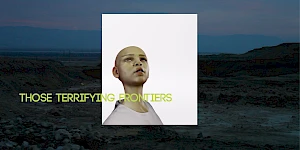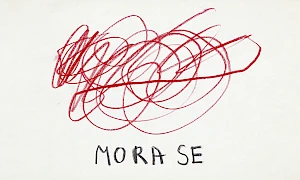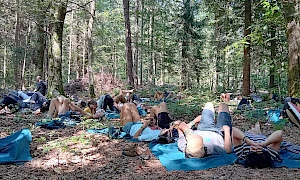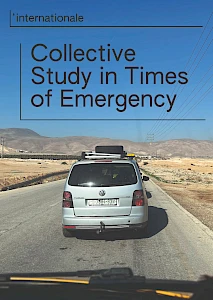Dispatch: Notes on (de)growth from the fragments of Yugoslavia's former alliances
In her dispatch from 'Summer School: Our Many Easts' artist and researcher Ava Zevop reflects on the recurring presence of the Non-Aligned Movement (NAM) within the programme. Through the writing of critical race theorist Ezekiel Dixon-Román, the practice of Krater collective, as well as her own research, she ponders the question of degrowth and the "lost potentialities" of NAM.

The view from Krater production space – located in a dormant construction site – in the city of Ljubljana. Photo: Ava Zevop
At the summer school ‘Our Many Easts’, the history of the Non-Aligned Movement (NAM) took an important role in queering West-South relations. This brings my thoughts back to the words of Ezekiel Dixon-Román, critical race and media theorist, on progress, development and difference, and consolidates the fragments of Yugoslavia’s former diplomatic and economic alliances – that I have been encountering in the recent years – into a reflection on (de)growth.
In a research group I am involved in exploring post-colonial and post-socialist encounters in art discourse and infrastructure between Lithuania and Slovenia, we have been privileging encounters as a form of knowledge production. During ‘Our Many Easts’, it is the encounter with Dubravka Sekulić, and her research on Energoprojekt that captures my interest in the lives of “growth”, “progress” and “development” within the Non-Alignment discourse – as she outlines the relations between the shifting policy of the UN and the internal pressures of the Yugoslav markets. Previously in Rijeka, another encounter with a group of Sino-Yugoslav researchers – who are tracing the history of Yugoslav-Chinese exchanges and their legacies and afterlives – gave me another entry point to think through the changing relations between these two regions in terms of development, and its past and present discursive manifestations. In the first of a series of encounters, I met Dutch-Yugoslav hacker, activist, and lecturer Vesna Manojlovic in Linz. In her lecture on the ‘Internet of the Ecocide’, she quotes Roland Ngam who said “Seven billion are already degrown”, and later she sparks my interest in the environmental politics of the Non-Aligned Movement – or lack thereof.
According to Dixon-Román, it is ‘time, history, and space (as demarcated by geographic context), or more specifically development’ that ‘became the necessary descriptors in the formations of sameness and difference as well as economic conditions, social conditions, human capacities, and even frameworks that inform social policies and practices of governance’. Dixon-Román claims, in relation to technology, that it is in part due to assumptions of development, progress, and narratives of cultural difference that racial logics becomes embedded within its discourse.
In the history of the Non-Aligned Movement, the notion of (under)development seems to not only hold many contradictory tensions but takes the role of a scapegoat in issues of global inequality, and power imbalance. As stated by Paul Stubbs, Yugoslavia existed as a project of “modernization otherwise”, with NAM as “globalization otherwise”. As we visit the local environmental initiative Krater the next day, I wonder about the lost potentialities for ecological justice within the project of Non-Alignment and what that means for the possibilities of “Non-Alignment otherwise”.

A vine coming through the window in the kitchen of the summer school accommodation. Photo: Ava Zevop

Forest Encounters with Urška Jurman, Mateja Kurir, Polonca Lovšin, part of the Summer School ‘Our Many Easts’. Photo: Ava Zevop

Mladi Levi Festival: Shared Landscapes, seven pieces between fields and forests. Photo: Ava Zevop

A (forgotten) private orchard near Ljubljana. Photo: Ava Zevop
Related activities
-
–Moderna galerijaZRC SAZU
Summer School: Our Many Easts

Our Many Easts summer school is organised by Moderna galerija in Ljubljana in partnership with ZRC SAZU (the Research Centre of the Slovenian Academy of Sciences and Arts) as part of the L’Internationale project Museum of the Commons.
-
–Van Abbemuseum
The Soils Project

‘The Soils Project’ is part of an eponymous, long-term research initiative involving TarraWarra Museum of Art (Wurundjeri Country, Australia), the Van Abbemuseum (Eindhoven, Netherlands) and Struggles for Sovereignty, a collective based in Yogyakarta, Indonesia. It works through specific and situated practices that consider soil, as both metaphor and matter.
Seeking and facilitating opportunities to listen to diverse voices and perspectives around notions of caring for land, soil and sovereign territories, the project has been in development since 2018. An international collaboration between three organisations, and several artists, curators, writers and activists, it has manifested in various iterations over several years. The group exhibition ‘Soils’ at the Van Abbemuseum is part of Museum of the Commons. -
–VCRC
Kyiv Biennial 2023

L’Internationale Confederation is a proud partner of this year’s edition of Kyiv Biennial.
-
–MACBA
Where are the Oases?

PEI OBERT seminar
with Kader Attia, Elvira Dyangani Ose, Max Jorge Hinderer Cruz, Emily Jacir, Achille Mbembe, Sarah Nuttall and Françoise VergèsAn oasis is the potential for life in an adverse environment.
-
MACBA
Anti-imperialism in the 20th century and anti-imperialism today: similarities and differences

PEI OBERT seminar
Lecture by Ramón GrosfoguelIn 1956, countries that were fighting colonialism by freeing themselves from both capitalism and communism dreamed of a third path, one that did not align with or bend to the politics dictated by Washington or Moscow. They held their first conference in Bandung, Indonesia.
-
Institute of Radical ImaginationMuseo Reina Sofia
Cinema as Assembly

Cinema as Assembly investigates cinema as a space of social gathering and political engagement that prefigures and enacts forms of living beyond colonial capitalism.
-
21 Jun 2023 –6 Jul Van AbbemuseumMaria Lugones Decolonial Summer School
Recalling Earth: Decoloniality and Demodernity
Course Directors: Prof. Walter Mignolo & Dr. Rolando VázquezRecalling Earth and learning worlds and worlds-making will be the topic of chapter 14th of the María Lugones Summer School that will take place at the Van Abbemuseum in Eindhoven.
-
23 Apr 2023 –30 Sep 2024 MSNArchive of the Conceptual Art of Odesa in the 1980s
The research project turns to the beginning of 1980s, when conceptual art circle emerged in Odesa, Ukraine. Artists worked independently and in collaborations creating the first examples of performances, paradoxical objects and drawings.
-
15 Feb 2024 –15 Mar Moderna galerijaZRC SAZUOpen Call – Summer School: Our Many Easts

Our Many Easts summer school takes place in Ljubljana 24–30 August and the application deadline is 15 March. Courses will be held in English and cover topics such as the legacy of the Eastern European avant-gardes, archives as tools of emancipation, the new “non-aligned” networks, art in times of conflict and war, ecology and the environment.
-
10 Feb 2024 –1 Apr MACBASong for Many Movements: Scenes of Collective Creation

An ephemeral experiment in which the ground floor of MACBA becomes a stage for encounters, conversations and shared listening.
-
5 Jun 2024 Museo Reina SofiaPalestine Is Everywhere

‘Palestine Is Everywhere’ is an encounter and screening at Museo Reina Sofía organised together with Cinema as Assembly as part of Museum of the Commons. The conference starts at 18:30 pm (CET) and will also be streamed on the online platform linked below.
-
10 Oct 2025 –18 Jan 2026 Kyiv Biennial 2025
L’Internationale Confederation is a proud partner of this years’ edition of the Kyiv Biennial.
-
6 Nov 2025 –6 Apr 2026 MACBAProject a Black Planet: The Art and Culture of Panafrica

Curated by MACBA director Elvira Dyangani Ose, along with Antawan Byrd, Adom Getachew and Matthew S. Witkovsky, Project a Black Planet: The Art and Culture of Panafrica is the first major international exhibition to examine the cultural manifestations of Pan-Africanism from the 1920s to the present.
-
13 Jun 2025 –21 Sep M HKAThe Geopolitics of Infrastructure

The exhibition The Geopolitics of Infrastructure presents the work of a generation of artists bringing contemporary perspectives on the particular topicality of infrastructure in a transnational, geopolitical context.
-
10 Nov 2025 –16 Nov MACBAMuseo Reina SofiaSchool of Common Knowledge 2025
The second iteration of the School of Common Knowledge will bring together international participants, faculty from the confederation and situated organisations in Barcelona and Madrid.
-
8 May 2025 –9 May Collective Study in Times of Emergency, Amsterdam

Within the context of ‘Every Act of Struggle’, the research project and exhibition at de appel in Amsterdam, L’Internationale Online has been invited to propose a programme of collective study.
-
25 Apr 2025 Museo Reina SofiaPoetry readings: Culture for Peace – Art and Poetry in Solidarity with Palestine

Casa de Campo, Madrid
Related contributions and publications
-

Reading list - Summer School: Our Many Easts
Summer School - Our Many Easts6 Sep 2024 Past in the PresentModerna galerija -

Dispatch: ‘I don't believe in revolution, but sometimes I get in the spirit.’
Megan Hoetger20 Sep 2024 Past in the Present -

…and the Earth along. Tales about the making, remaking and unmaking of the world.
Martin Pogačar14 Nov 2023 ... and the Earth alongClimatePast in the Present -

The Kitchen, an Introduction to Subversive Film with Nick Aikens, Reem Shilleh and Mohanad Yaqubi
Nick Aikens, Subversive Film13 Jul 2023 lumbungPast in the PresentVan Abbemuseum -

The Repressive Tendency within the European Public Sphere
Ovidiu Ţichindeleanu6 Dec 2023 Towards Collective Study in Times of EmergencyPast in the Present -

Troubles with the East(s)
Bojana Piškur22 Jan 2024 Towards Collective Study in Times of EmergencyPast in the Present -

Right now, today, we must say that Palestine is the centre of the world
Françoise Vergès21 Dec 2023 Towards Collective Study in Times of EmergencyPast in the Present -
Body Counts, Balancing Acts and the Performativity of Statements
Mick Wilson20 Dec 2023 Towards Collective Study in Times of EmergencyPast in the Present -

Until Liberation I: Learning Palestine
Learning Palestine Group8 Dec 2023 Towards Collective Study in Times of EmergencyPast in the Present -

Until Liberation II: Learning Palestine
Learning Palestine Group12 Jan 2024 Towards Collective Study in Times of EmergencyPast in the Present -

The Veil of Peace
Ovidiu Ţichindeleanu31 Oct 2023 Past in the Presenttranzit.ro -
Editorial: Towards Collective Study in Times of Emergency
L’Internationale Online Editorial Board29 Nov 2023 Towards Collective Study in Times of EmergencyStatements and editorialsPast in the PresentEN es sl tr ar -

Opening Performance: Song for Many Movements, live on Radio Alhara
Jokkoo with/con Miramizu, Rasheed Jalloul & Sabine Salamé23 Feb 2024 Towards Collective Study in Times of EmergencySonic CommonsPast in the PresentMACBAEN es -

We Have Been Here Forever. Palestinian Poets Write Back
Rana Issa4 Mar 2024 Towards Collective Study in Times of EmergencyPast in the PresentEN tr ar -

Indra's Web
Vandana Singh1 Mar 2024 ... and the Earth alongPast in the PresentClimateZRC SAZU -

Diary of a Crossing
Baqiya and Yu’ad27 Mar 2024 Towards Collective Study in Times of EmergencyPast in the Present -

The Silence Has Been Unfolding For Too Long
The Free Palestine Initiative Croatia11 Apr 2024 Towards Collective Study in Times of EmergencyPast in the PresentSituated OrganizationsInstitute of Radical ImaginationMSU Zagreb -

Everything will stay the same if we don’t speak up
L’Internationale Confederation17 Apr 2024 Towards Collective Study in Times of EmergencyStatements and editorialsPast in the PresentSituated OrganizationsEN ca -

War, Peace and Image Politics: Part 1, Who Has a Right to These Images?
Jelena Vesić14 May 2024 Past in the PresentZRC SAZU -

Live set: A Love Letter to the Global Intifada
Precolumbian13 Jun 2024 Towards Collective Study in Times of EmergencySonic CommonsPast in the PresentMACBAEN es -

Cultivating Abundance
Åsa Sonjasdotter28 Jun 2024 The Climate ForumClimatePast in the Present -

The Genocide War on Gaza: Palestinian Culture and the Existential Struggle
Rana Anani10 Sep 2024 Towards Collective Study in Times of EmergencyPast in the Present -

Eating clay is not an eating disorder
Zayaan Khan17 Sep 2024 The Climate ForumRecette. Reset. Recipes in and Beyond the InstitutionClimatePast in the Present -

Dispatch: Notes on (de)growth from the fragments of Yugoslavia's former alliances
Ava Zevop24 Sep 2024 Past in the Present -

Forget ‘never again’, it’s always already war
Martin Pogačar3 Oct 2024 Towards Collective Study in Times of EmergencyPast in the PresentZRC SAZU -

Beyond Distorted Realities: Palestine, Magical Realism and Climate Fiction
Sanabel Abdel Rahman14 Nov 2024 Towards Collective Study in Times of EmergencyPast in the PresentClimate -

Collective Study in Times of Emergency. A Roundtable
Nick Aikens, Sara Buraya Boned, Charles Esche, Martin Pogačar, Ovidiu Ţichindeleanu, Ezgi Yurteri15 Nov 2024 Towards Collective Study in Times of EmergencyPast in the PresentSituated Organizations -

Present Present Present. On grounding the Mediateca and Sonotera spaces in Malafo, Guinea-Bissau
Filipa César27 Nov 2024 Past in the Present -

Collective Study in Times of Emergency
2024 Towards Collective Study in Times of EmergencyPast in the Present -

Milad: The Birth of a Dream and Its Continuation
Sanaa Salameh20 Jan 2025 Towards Collective Study in Times of EmergencyPast in the PresentEN ar -

The Library and the Massacre: A Novelist's Testimony on the Destruction of Libraries in the Gaza Strip
Yousri al-Ghoul20 Jan 2025 Towards Collective Study in Times of EmergencyPast in the PresentEN ar -

Black Archives: Episode I. Radical Internationalism and Pan-Africanism in the context of the Spanish Civil War
Tania Safura Adam5 Feb 2025 Past in the PresentEN es -

Re-installing (Academic) Institutions: The Kabakovs’ Indirectness and Adjacency
Christa-Maria Lerm Hayes14 Feb 2025 Past in the Present -

A Date Palm Against the Re-Deportation of Parables, or Europe’s Palestine Monument
Robert Yerachmiel Sniderman8 Apr 2025 Towards Collective Study in Times of EmergencyPast in the PresentMSNEN pl -

Mass Student Protests in Serbia: The possibility of different social relations
Marijana Cvetković, Vida Knežević31 Mar 2025 Past in the PresentEN rs